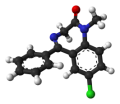Wikisage, the free encyclopedia of the second generation, is digital heritage
Diazepam: Difference between revisions
Jump to navigation
Jump to search
mNo edit summary |
m (→ATC code N05) |
||
| Line 6: | Line 6: | ||
<ref>[http://www.neurologia.com/pdf/web/2902/h020121.pdf "Floppy infant" en gemelos por uso de benzodiacepinas durante la gestación]</ref> | <ref>[http://www.neurologia.com/pdf/web/2902/h020121.pdf "Floppy infant" en gemelos por uso de benzodiacepinas durante la gestación]</ref> | ||
==ATC code N05== | ==[[ATC code N05|ATC]]== | ||
{| style="background:Ivory; color:black" border=1 cellspacing=1 cellpadding=5 | {| style="background:Ivory; color:black" border=1 cellspacing=1 cellpadding=5 | ||
Latest revision as of 03:39, 26 August 2017
Diazepam is highly lipophylic benzodiazepine, which rapidly enters into the brain but subsequently is redistributed into peripheral tissues[1]
ATC
- Pain control using pethidine in combination with diazepam compared to diclofenac in combination with hyoscine-n-butyl bromide: in patients undergoing extracorporeal shock wave lithotripsy
- Evaluation of the efficacy of sodium valproate in convulsive status epilepticus following to ıschemic stroke
- Diazepam or midazolam for orotracheal intubation in the ICU?
- Diazepam por Vía Rectal en Ninos con Crisis Epilépticas
- Safety and efficacy of buccal midazolam versus rectal diazepam for emergency treatment of seizures in children: a randomised controlled trial
